Designing Surveys: A Guide to Decisions and Procedures
Autor Ronald Czaja, Johnny Blair Editat de Ronald F. Czajaen Limba Engleză Hardback – 30 noi 2004
Key Features:
A comprehensive section on internet surveys, their methodology, summary of experiences and practices to date and how internet surveys interface with more traditional methods.
Changes in telephone survey design and data collection procedures due to rising nonresponse rates (this will include combined methods of data collection and the use of respondent incentives) and call screening (and other) technologies
The increase use of web sites and package programs for variance estimation, data analysis and data dissemination
Preț: 515.85 lei
Preț vechi: 661.35 lei
-22% Nou
Puncte Express: 774
Preț estimativ în valută:
98.71€ • 103.06$ • 81.69£
98.71€ • 103.06$ • 81.69£
Carte tipărită la comandă
Livrare economică 04-15 aprilie
Preluare comenzi: 021 569.72.76
Specificații
ISBN-13: 9780761927457
ISBN-10: 076192745X
Pagini: 301
Dimensiuni: 160 x 237 x 23 mm
Greutate: 0.56 kg
Ediția:Second.
Editura: PINE FORGE PR
Locul publicării:Thousand Oaks, United States
ISBN-10: 076192745X
Pagini: 301
Dimensiuni: 160 x 237 x 23 mm
Greutate: 0.56 kg
Ediția:Second.
Editura: PINE FORGE PR
Locul publicării:Thousand Oaks, United States
Recenzii
"In Designing surveys, Ronald Czaja and Johnny Blair do an excellent job of giving the academic and professional viewpoints of creating, conducting, and presenting small- to moderate-scale survey information. Designing surveys does an excellent job of defining each type of survey and providing sample question to consider. The graphics and tables presented in each chapter show the amount of research that Czaja and Blair have put into the content in this book."
"Designing Surveys: A Guide to Decisions and Procedures is, to paraphrase the authors' words, a practical and realistic guide to conducting small-to-moderate scale surveys. This is a book aimed at those beginning their survey research experience. The well-written and clearly organized text would be best suited to advanced undergraduates or graduate students beginning their own research, Czaja and Blair have clearly made an effort to build rapport with undergraduate students. Faculty adopting Designing Surveys: A Guide to Decisions and Procedures will appreciate the attention paid to the details of survey design."
"A practical and realistic guide to conducting small-to-moderate scale surveys, this is a book aimed at those beginning their survey research experience. The well-written and clearly organized text would be best suited to advanced undergraduates or graduate students beginning their own research."
"A practical and realistic guide to conducting small-to-moderate scale surveys, this is a book aimed at those beginning their survey research experience. The well-written and clearly organized text would be best suited to advanced undergraduates or graduate students beginning their own research."
"Designing Surveys: A Guide to Decisions and Procedures is, to paraphrase the authors' words, a practical and realistic guide to conducting small-to-moderate scale surveys. This is a book aimed at those beginning their survey research experience. The well-written and clearly organized text would be best suited to advanced undergraduates or graduate students beginning their own research, Czaja and Blair have clearly made an effort to build rapport with undergraduate students. Faculty adopting Designing Surveys: A Guide to Decisions and Procedures will appreciate the attention paid to the details of survey design."
"A practical and realistic guide to conducting small-to-moderate scale surveys, this is a book aimed at those beginning their survey research experience. The well-written and clearly organized text would be best suited to advanced undergraduates or graduate students beginning their own research."
"A practical and realistic guide to conducting small-to-moderate scale surveys, this is a book aimed at those beginning their survey research experience. The well-written and clearly organized text would be best suited to advanced undergraduates or graduate students beginning their own research."
Cuprins
Series Foreword
Preface
Chapter 1. An Introduction to Surveys and to This Book
The Practice of Survey Research
The Uses of Surveys
Overview of the Survey Process
A Brief Summary of This Book
Chapter 2. Stages of a Survey
Stage 1: Survey Design and Preliminary Planning
Stage 2: Pretesting
Stage 3: Final Survey Design and Planning
Stage 4: Data Collection
Stage 5: Data Coding, Data-File Construction, Analysis, and Final Report
Example of a Time Schedule for a Study
Chapter 3. Selecting the Method of Data Collection
Evaluating the Advantages and Disadvantages of the Four Survey Methods
Mail Surveys
Internet Surveys
Telephone Surveys
Face-to-Face Surveys
Combinations of Methods
Chapter 4. Questionnaire Design: Writing the Questions
Questionnaire Design as Process
Factors in Questionnaire Development
Writing Questions
Chapter 5. Questionnaire Design: Organizing the Questions
Introducing the Study
What Questions Should the Questionnaire Begin With?
Grouping Questions into Sections
Questionnaire Length and Respondent Burden
Avoiding Other Flaws in Mail Questionnaire Design
Chapter 6. Questionnaire Design: Testing the Questions
Importance of Respondents' Comprehension of and Ability to Answer Questions
Conventional Pretests and Interviewer Debriefings
Post-Interview Interviews
Behavior Coding
A Note on Intercoder Reliability
Cognitive Interviews
Respondent Debriefing
Expert Panel
Examining Interviewer Tasks
Revising and Retesting: Deciding Which Pretest Problems to Address
Deciding How Much Testing Is Enough
Pilot Tests
Combined Methods
Some Last Advice
Chapter 7. Designing the Sample
The Basics
Defining the Population
Constructing a Sampling Frame
Matching Defined Populations and Sampling Frames
Recognizing Problems with Sampling Frames
Determining Sample Size
Hypothesis Testing and Power
Using Census Data
Chapter 8. Selecting a Sample
Example 1: A Community List-Assisted Telephone Sample
Example 2: A Directory-Based Community Telephone Sample
Example 3: Other RDD Telephone Samples
Selecting Respondents within Households
Example 4: A List Sample of Students
Example 5: A Sample of University Classes
Chapter 9. Reducing Sources of Error in Data Collection
The Origins of Error
Chapter 10. Special Topics
Ethical Issues in Survey Research
The Methodology Report
The Utility of the Methodology Report
What to Include in the Methodology Report
Costs and Contingencies: Planning for the Unexpected
For Further Study: Suggested Readings
Appendix A
Appendix B
Appendix C
Glossary/Index
Preface
Chapter 1. An Introduction to Surveys and to This Book
The Practice of Survey Research
The Uses of Surveys
Overview of the Survey Process
A Brief Summary of This Book
Chapter 2. Stages of a Survey
Stage 1: Survey Design and Preliminary Planning
Stage 2: Pretesting
Stage 3: Final Survey Design and Planning
Stage 4: Data Collection
Stage 5: Data Coding, Data-File Construction, Analysis, and Final Report
Example of a Time Schedule for a Study
Chapter 3. Selecting the Method of Data Collection
Evaluating the Advantages and Disadvantages of the Four Survey Methods
Mail Surveys
Internet Surveys
Telephone Surveys
Face-to-Face Surveys
Combinations of Methods
Chapter 4. Questionnaire Design: Writing the Questions
Questionnaire Design as Process
Factors in Questionnaire Development
Writing Questions
Chapter 5. Questionnaire Design: Organizing the Questions
Introducing the Study
What Questions Should the Questionnaire Begin With?
Grouping Questions into Sections
Questionnaire Length and Respondent Burden
Avoiding Other Flaws in Mail Questionnaire Design
Chapter 6. Questionnaire Design: Testing the Questions
Importance of Respondents' Comprehension of and Ability to Answer Questions
Conventional Pretests and Interviewer Debriefings
Post-Interview Interviews
Behavior Coding
A Note on Intercoder Reliability
Cognitive Interviews
Respondent Debriefing
Expert Panel
Examining Interviewer Tasks
Revising and Retesting: Deciding Which Pretest Problems to Address
Deciding How Much Testing Is Enough
Pilot Tests
Combined Methods
Some Last Advice
Chapter 7. Designing the Sample
The Basics
Defining the Population
Constructing a Sampling Frame
Matching Defined Populations and Sampling Frames
Recognizing Problems with Sampling Frames
Determining Sample Size
Hypothesis Testing and Power
Using Census Data
Chapter 8. Selecting a Sample
Example 1: A Community List-Assisted Telephone Sample
Example 2: A Directory-Based Community Telephone Sample
Example 3: Other RDD Telephone Samples
Selecting Respondents within Households
Example 4: A List Sample of Students
Example 5: A Sample of University Classes
Chapter 9. Reducing Sources of Error in Data Collection
The Origins of Error
Chapter 10. Special Topics
Ethical Issues in Survey Research
The Methodology Report
The Utility of the Methodology Report
What to Include in the Methodology Report
Costs and Contingencies: Planning for the Unexpected
For Further Study: Suggested Readings
Appendix A
Appendix B
Appendix C
Glossary/Index
Descriere
The Second Edition of Designing Surveys: A Guide to Decisions and Procedures accounts for changes in telephone, Internet, and email surveying and provides a more comprehensive treatment on questionnaire testing. Despite changing technologies, however, the principles of scientific survey design remain unchanged, including the selection of the sample, the writing of questions to solicit an unbiased response, and the ethical treatment of human subjects. This new edition addresses these issues in the context of new and emerging technologies and their relationship to survey design and the social sciences. Designing Surveys provides an accurate account of how modern survey research is actually conducted, but with the needs and goals of a novice researcher in mind.




